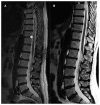Spinal dural and epidural arteriovenous fistula: Recurrence rate after surgical and endovascular treatment
- PMID: 37082364
- PMCID: PMC10111007
- DOI: 10.3389/fsurg.2023.1148968
Spinal dural and epidural arteriovenous fistula: Recurrence rate after surgical and endovascular treatment
Abstract
Introduction: Spinal dural arteriovenous fistula consist of an heterogenous group of vascular malformation often causing severe neurological deficit due to progressive myelopathy. This type of malformation could be associated with subarachnoid or subdural hemorrhage inside the spinal canal. In the English literature surgical treatment is regarded as the best option if compared to endovascular procedure, being the latter associated with an increased risk of relapse despite its less invasiveness.
Methods: In this study a retrospective analysis of 30 patients with spinal dural and epidural fistula associated with perimedullary venous congestion was undertaken. The radiological and clinical presentation of each patient is analyzed, and the grade of myelopathy is classified through the mJOA score.
Results: A total number of 31 out of 41 collected procedures (22 surgery vs. 19 endovascular) were dural fistulas while the remaining 10 were classified as epidural. A 46% recurrence rate for endovascular treatment against 0% for surgical (p-value 0.004) was described for dural fistulas, while in the epidural fistula group the rate of recurrence was 80% and 20% respectively for endovascular and surgery treatment (p-value 0.6).
Discussion: According to the results, surgical treatment could be considered as first-line treatment for spinal dural arteriovenous fistulas. Endovascular embolization can be proposed in selected cases, as a less invasive technique, for elderly patients or with important comorbidities. In spinal epidural arteriovenous fistulas, in view of the greater invasiveness of the surgical treatment and the non-significant difference in terms of recurrence risk between the two techniques, endovascular treatment could be proposed as a first choice treatment; in the event of a recurrence, a surgical intervention will instead be proposed in a short time.
Keywords: endovascular treatment; epidural fistula; spinal AVMs; spinal fistula; spinal neurosurgery.
© 2023 Vercelli, Minardi, Bergui, Zenga, Garbossa and Cofano.
Conflict of interest statement
The authors declare that the research was conducted in the absence of any commercial or financial relationships that could be construed as a potential conflict of interest.
Figures




Similar articles
-
Spinal Epidural Fistulas-A Separate Entity to Dural Fistulas with Different Angioarchitecture and Treatment Approach.World Neurosurg. 2021 May;149:e600-e611. doi: 10.1016/j.wneu.2021.01.126. Epub 2021 Feb 3. World Neurosurg. 2021. PMID: 33548535
-
Surgical Management of Spinal Dural Arteriovenous Fistula: A Case Report.Cureus. 2025 Feb 22;17(2):e79440. doi: 10.7759/cureus.79440. eCollection 2025 Feb. Cureus. 2025. PMID: 40130091 Free PMC article.
-
Spinal epidural arteriovenous fistula with late onset perimedullary venous hypertension after lumbar surgery: case report and discussion of the pathophysiology.Spine (Phila Pa 1976). 2009 Oct 1;34(21):E775-9. doi: 10.1097/BRS.0b013e3181ae4a52. Spine (Phila Pa 1976). 2009. PMID: 19934798
-
Spinal cord arteriovenous shunts: from imaging to management.Eur J Radiol. 2003 Jun;46(3):221-32. doi: 10.1016/s0720-048x(03)00093-7. Eur J Radiol. 2003. PMID: 12758116 Review.
-
Vascular malformations of the spinal cord and dura.Neurosurg Clin N Am. 1990 Jul;1(3):631-52. Neurosurg Clin N Am. 1990. PMID: 2136162 Review.
Cited by
-
Endovascular treatment of epidural arteriovenous fistula associated with sacral arteriovenous malformation: case report.Front Neurol. 2024 Feb 12;15:1326182. doi: 10.3389/fneur.2024.1326182. eCollection 2024. Front Neurol. 2024. PMID: 38410195 Free PMC article.
-
An Update on Spinal Dural Arteriovenous Fistulae: Case Series and Systematic Review.Cureus. 2024 Jul 27;16(7):e65537. doi: 10.7759/cureus.65537. eCollection 2024 Jul. Cureus. 2024. PMID: 39188459 Free PMC article.

